Oceans and islands Part Two
Flying fish and fickle winds
‘There’s a world of difference between saying ‘I want to’ and ‘I will” (Bernard Moitessier)
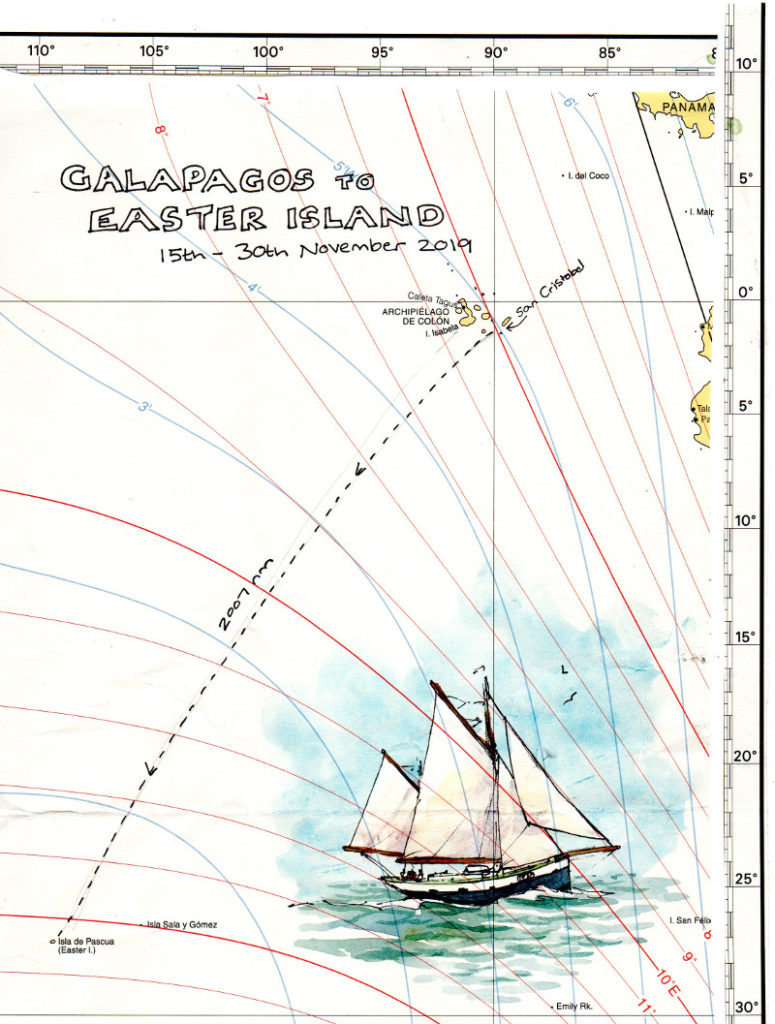
It took us thirteen days to sail from San Cristobal in the Galapagos to Rapa Nui (Easter Island), a voyage of 2,007 miles. In that time we saw three ships, plenty of flying fish and the blowing of a distant whale. Not having done an ocean passage under sail before, I had no idea how easy I would find it filling the pages of my brand new A4 sketchbook, nor what form it would take. I gave myself three days before starting so that I could hopefully get my sea legs and work out how to begin.

Gradually I got the hang of it, finding something different every day to draw and write. I tried to do at least one page a day, sometimes it spread to two. Most sketchbooks start hesitantly and then I get into my stride and this was no exception.
Sailing the open ocean in the tropics is in many ways so much easier than along the coast of the UK and Europe with its tides, headlands, fishing boats, ferries, shipping lanes, shoals, rocks, unmarked crab pots, crowded harbours, changeable weather, and endless wind farms! When I first took the wheel, anxious to try and get the feel of it so that I could steer a compass course reliably, I asked the Captain: how long are we on this course for? Oh, about two weeks, was his reply. Around us, day after day, was our blue circle of empty ocean. Nothing to see but the sea. For some reason, I found that immensely soothing (perhaps I just spent too many years trying to enjoy sailing the North Sea and English Channel!).
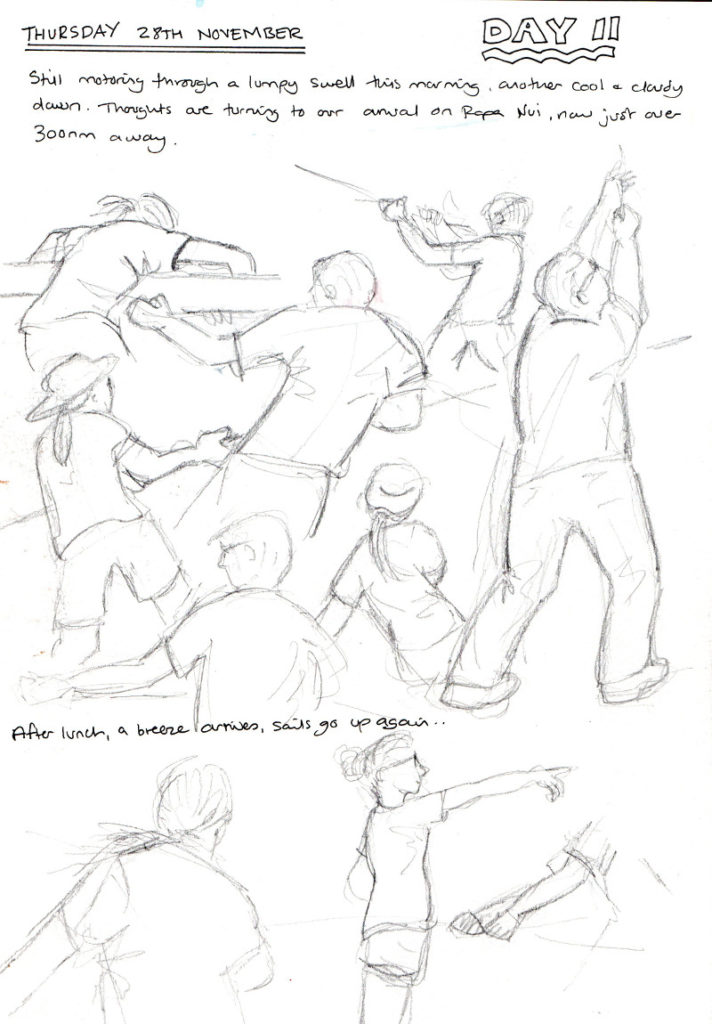
Being out of contact with the wider world, no phone or internet, was surprisingly pleasurable. The desire to keep checking messages, emails and social media stops very quickly when you know you can’t do it! We were happy to be for a while ignorant of whatever political dramas and human conflicts were playing out in the shouty, people-inhabited bits of the planet. We knew it would all still be there when we get back on land, but the only thing that mattered for us was our small world of 15 people and a strong, fast little ship. We noticed the subtle changes in sea colour and swell, we worked with the fickle winds – too little, too much, sometimes just right. We were a mix of Dutch, English, American, Australian, New Zealand, Irish and Scottish; conversations on the long night watches have been far ranging. Twice on the voyage the weather was calm enough for us to stop and have a swim; that is an experience I never thought I’d have, swimming in mid Pacific in a clear cobalt sea, the nearest land 4km below my feet.
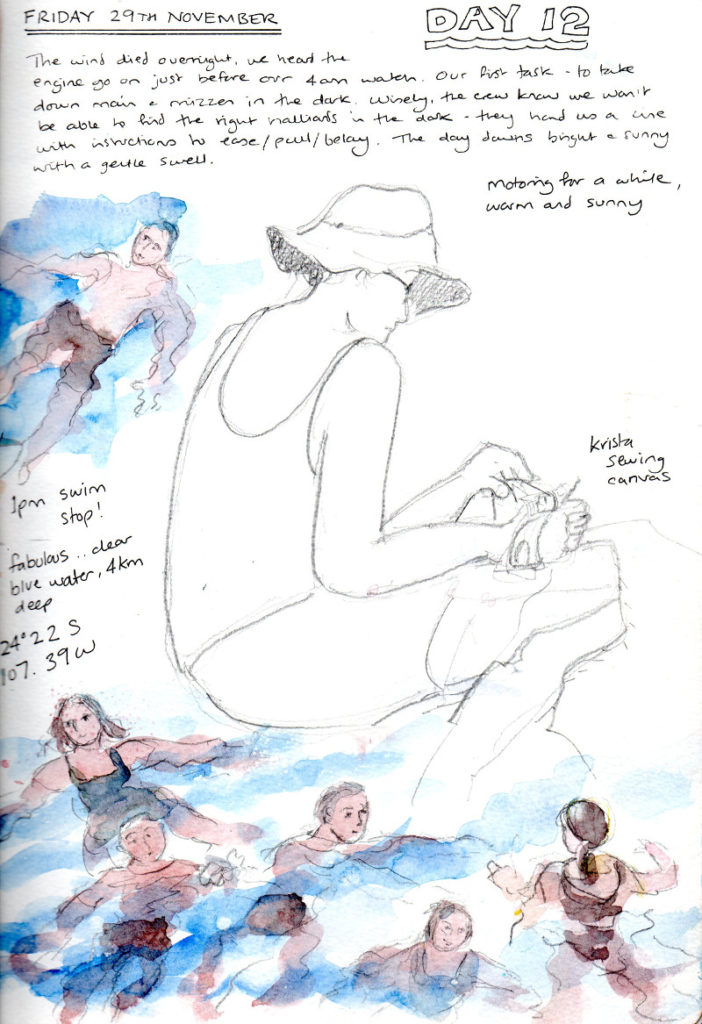
When I say that sailing in the middle of an ocean is easy as there’s nothing to hit, I mean it’s easy for us as crew (eat, sleep, steer, keep watch, hoist and trim sails, sit around and gaze at the sea for a bit, eat, sleep….) – but the preparations needed for a long voyage, and the skills to carry it out, are far ranging. Tecla’s owners, Jannette, Jet and Gjis Sluik, starting planning this trip two years before it began, and invested a huge amount of time and money to make sure it would be a success. The ship left the Netherlands in April 2019 and sailed north to Scotland, Iceland, Greenland and the North West Passage before heading south down the coast of Alaska and California to the Galapagos. By the time she returns to the Netherlands in autumn of 2020 she will have been away for 18 months, circumnavigated the Americas, called at Antarctica and stopped for a refit at Cape Town. (to find out more check out www.tecla-sailing.com)

She is a remarkably well equipped ship, capable of being self sufficient at sea for long periods. She has two generators, a watermaker, comprehensive food stores and navigation equipment; the family have taken her round the world before and know exactly what they are doing. Later in the voyage, in tougher and rougher seas I would come to appreciate how reassuringly strong and seaworthy she is.
Rapa Nui is over 1,000 miles away from the nearest land. It was discovered (by accident, as most islands are) on Easter day in 1723 by a Dutch explorer called Roggerveen and the wonder of it is that he or anyone else ever managed to find it again. He would have been astonished to see the navigation equipment we have available, which tells us all the time exactly where we are and how many miles to our destination.
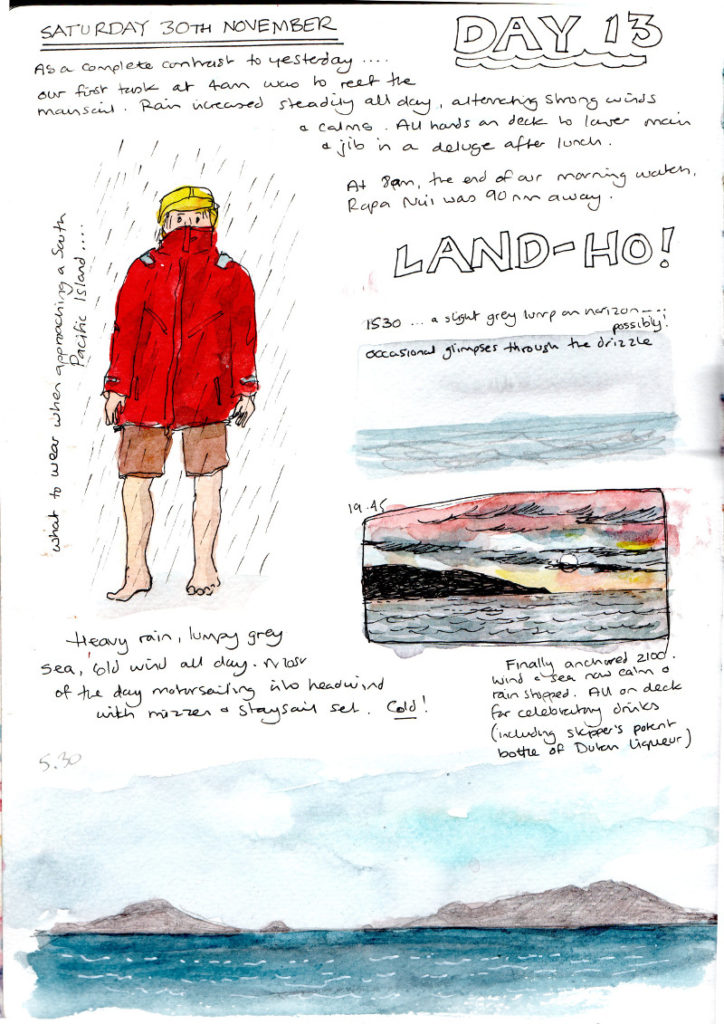
I didn’t expect my first sight of Rapa Nui to be a grey murky blob on a cold, grey, drizzly horizon, but that’s what it was. The grey blob grew larger throughout the day but the drizzle only stopped when we dropped anchor, after dark, in a silent bay to the north of the island. Only a couple of pinpricks of light showed some human habitation.
Rapa Nui has no harbour, just an anchorage in a bay close to the only town, Hanga Roa, on the south west corner of the island. Getting ashore to the tiny fishing quay meant running through a gap in the surf which occasionally wasn’t a gap at all – hold tight and don’t look behind you! When the wind changes, which it did, we had to move anchorage round the corner. The wind blew hard and occasionally the drizzle came back, obscuring the top of the volcano at the edge of our anchorage.

My sketchbook of Rapa Nui only contains a few pages as I had such a short time ashore – one night in a hotel and a trip round the island in a hired car with a fellow crewmate. I’d like to have stayed longer. The people are proud of their Polynesian heritage, but depend heavily on Chile for supplies and support. There is little fishing, increasing tourism, and most of the island is designated National Park. No cruise ships can call because there’s no harbour to bring them ashore.
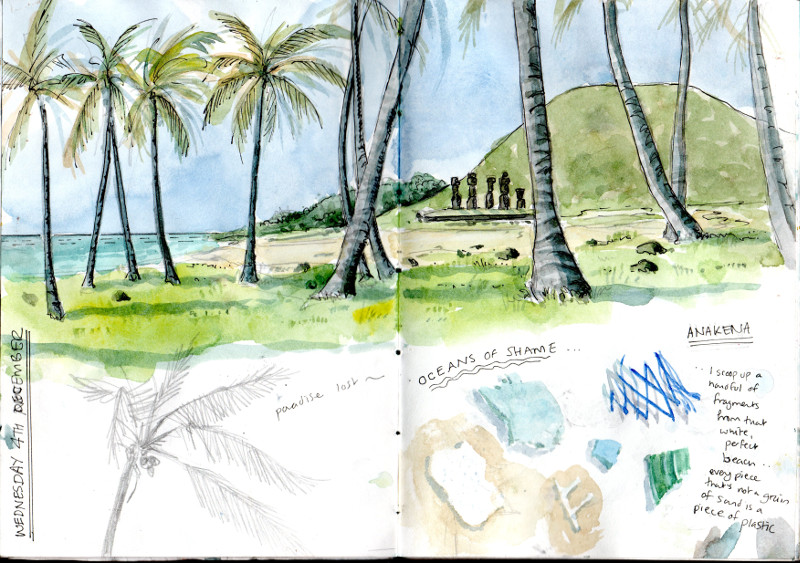
Most people are familiar with the tragedy of Easter Island, how the early Polynesian settlers became so obsessed by building their moai, the stone statues, that they felled all the trees on the island to transport them and rendered the island barren and their lives unsustainable. Digging a bit deeper, it appears it didn’t happen quite like that, but was a complex chain of events including the usual human failings of inter-tribal warfare, diseases from visiting ships, overpopulation and other factors. The usual sorry tale of human history on a smaller scale. It certainly has atmosphere though, and the moai are impressive.
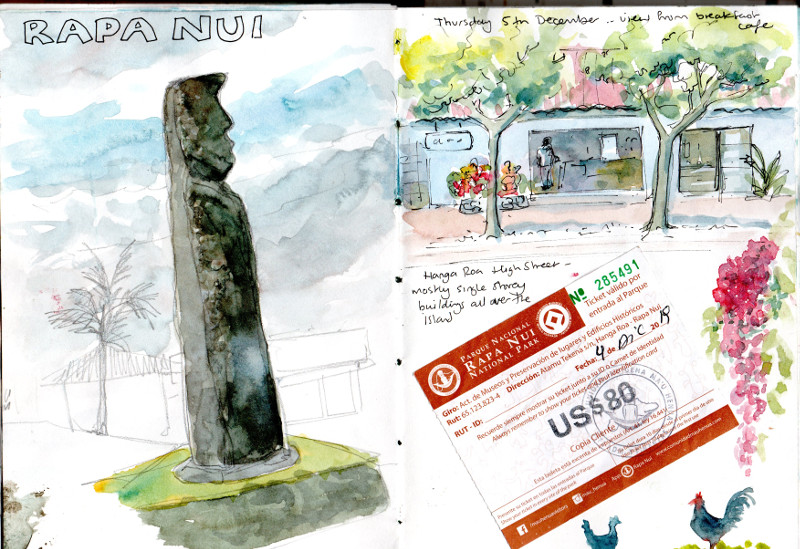
Tecla was having a change of voyage crew at Rapa Nui, so my shipmates from the last two weeks were leaving, and a new bunch arriving. I was the only one staying on to do the next leg of the voyage to the Falklands. There was a change of captain too; Gijs flew home and his sister Jet arrived to take his place for the next leg. Two of the professional crew, Will and Krista, were staying on as well.
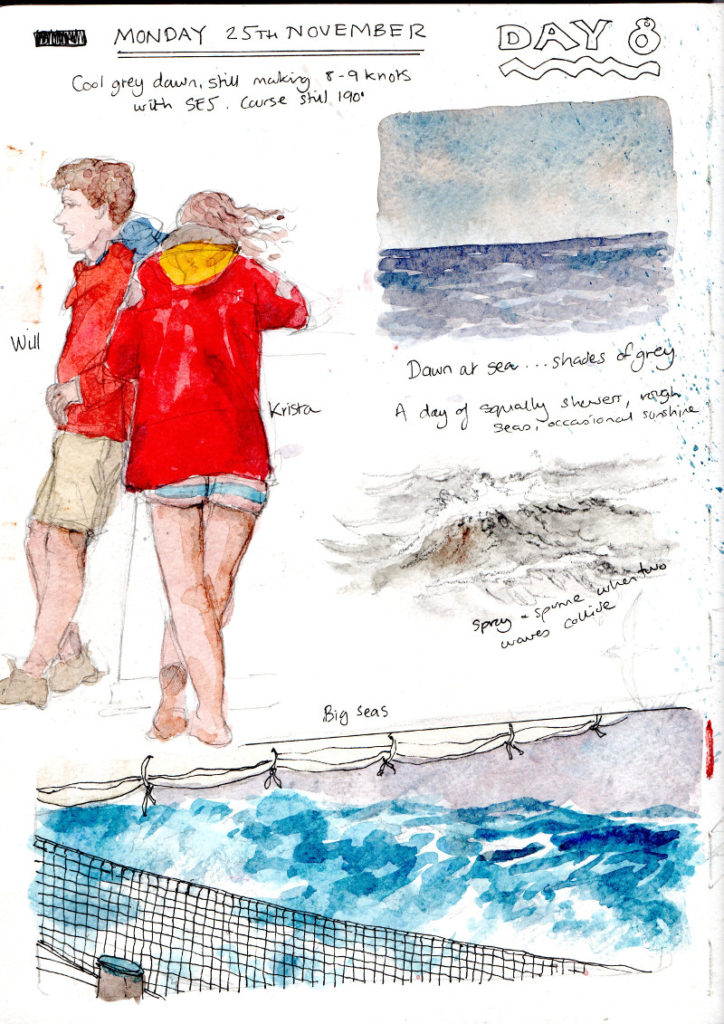
For the few days I was on the island, the next part of the voyage was on my mind; this for me was the big challenge. I’d got my sea legs, at least for the fairly benign tropical seas we’d had so far, but we were heading round Cape Horn, the sailor’s Mount Everest. Would I just endure it, or would I enjoy it too? I was about to find out.

Gripping stuff!
Surely it haf already been “discovered”
Brilliant Claudia.. so, so interesting. Reassuring that you struggle to ‘get started!’ with your sketch book! You are an inspiration! Xx
Loving this! I think the swim in the Pacific is a highlight & landing on Rapa Nui sounds like Sunday/Raoul, Pitcairn & Norfolk Is. – through the surf. In some ways it does protect them from the horror of mass cruise ship tourism. I liked your quote from Moitessier too – a reminder to self. Awaiting next instalment …
What a storyteller you are, Claudia. I was transported. I cheered when you said no cruise boats could anchor at Easter Island. Excellent. Swimming in the Pacific with no evidence of other human activity (planes, boats) nearby must have been bliss. What were the starry heavens like? Thank you!